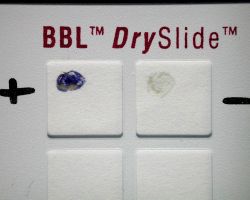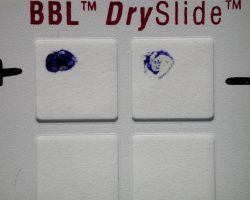SEARCH
Search
Oxidase test
-
General
The oxidase test is used to identify bacteria that produce cytochrome c oxidase, an enzyme of the bacterial electron transport chain.
When present, the cytochrome c oxidase oxidizes the reagent (teramethyl-p-phenylenediamine) to (indophenols) purple color end product.
When the ezymes is not present, the reagent remains reduced and is colorless.
Expected results of oxidase test
1. Positive: Development of dark purple clor (indophenols) within 10 seconds.
2. Negative: Absence of color.
Strains may be either oxidase-positive (OX+) or oxidase-negative (OX-).
OX+
OX+ normally means the bacterium contains cytochrome c oxidase and can therefore use oxygen for energy production by converting O2 to H2O2 or H2O with an electron transfer chain.
- Pseudomonadaceae are typically OX+
- Gram negative diplococci Neisseria and Moraxella are OX+
- Many Gram-negative, spiral curved rods which includes Helicobacter pylori, Vibrio cholerae and Campylobacter jejuni are OX+
Oxidase Variable
- Legionella pneumophila may be OX+
OX−
OX− normally means the bacterium does not contain cytochrome c oxidase and, therefore, either cannot use oxygen for energy production with an electyron transfer chain or employs a different cytochrome for transferring electrons to oxygen.
- Enterobacteriaceae are typically OX−
-
History
-
Related
-
References
Microbe Online
http://microbeonline.com/oxidase-test-principle-procedure-and-oxidase-positive-organisms/
Wikipedia


